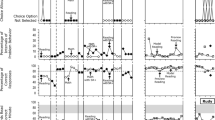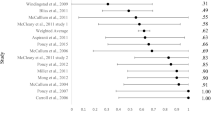Abstract
Noncontingent reinforcement (NCR) can be described as time-based or response-independent delivery of stimuli with known reinforcing properties. Previous research has shown NCR to reduce problem behavior in individuals with developmental disabilities and to interfere with the acquisition of more desired alternative behavior. To date, however, little research has examined the effects of NCR on children’s academic performance. The present study examined the effects of NCR on the completion of math computation worksheets by 3 students in an elementary school setting. An ABCB reversal design was used to compare an NCR schedule in combination with contingent reinforcement to contingent reinforcement alone. Results showed that digits correct per session decreased to baseline levels for all 3 students during implementation of the NCR plus contingent reinforcement condition. Implications of these results for the reductive effects of NCR are discussed.

Similar content being viewed by others
References
Fisher, W., Piazza, C. C., Bowman, L. G., Hagopian, L. P., Owens, J. C., & Slevin, I. (1992). A comparison of two approaches for identifying reinforcers for persons with severe and profound disabilities. Journal of Applied Behavior Analysis, 25, 491–498.
Goh, H. L., Iwata, B. A., & DeLeon, I. G. (2000). Competition between noncontingent and contingent reinforcement schedules during response acquisition. Journal of Applied Behavior Analysis, 33, 195–205.
Hagopian, L. P., Fisher, W. W., & Legacy, S. M. (1994). Schedule effects of noncontingent reinforcement on attention-maintained destructive behavior. Journal of Applied Behavior Analysis, 27, 317–325.
Marcus, B. A., & Vollmer, T. R. (1996). Combining noncontingent reinforcement and differential reinforcement schedules as treatment for problem behavior. Journal of Applied Behavior Analysis, 29, 43–51.
Martens, B. K., Hilt, A., Needham, L. R., Sutterer, J. R., Panahon, C. J., & Lannie, A. L. (2003). Carryover effects of free reinforcement on children’s work completion. Behavior Modification, 27(4), 560–577.
Myerson, J., & Hale, S. (1984). Practical implications of the matching law. Journal of Applied Behavior Analysis, 17, 367–380.
Northup, J., George, T., Jones, K., Broussard, C., & Vollmer, T. R. (1996). A comparison of reinforcer assessment methods: The utility of verbal and pictorial choice procedures. Journal of Applied Behavior Analysis, 29, 201–212.
Parker, R. I., & Vannest, K. J. (2009). An improved effect size for single case research: NonOverlap of All Pairs (NAP). Behavior Therapy, 40, 357–367.
Shapiro, E. S. (2011). Academic skills problems: Direct assessment and intervention (4th ed.). New York, NY: The Guilford Press.
Shinn, M. R. (1989). Curriculum-based measurement: Assessing special children. New York, NY: The Guilford Press.
Vollmer, T. R., Iwata, B. A., Zarcone, J. R., Smith, R. G., & Mazalewski, J. L. (1993). The role of attention in the treatment of attention-maintained self-injurious behavior: Noncontingent reinforcement and differential reinforcement of other behavior. Journal of Applied Behavior Analysis, 26, 9–21.
Vollmer, T. R., Marcus, B. A., & Ringdahl, J. E. (1995). Noncontingent escape as treatment for self-injurious behavior maintained by negative reinforcement. Journal of Applied Behavior Analysis, 28, 15–26.
Author information
Authors and Affiliations
Corresponding author
Rights and permissions
About this article
Cite this article
Panahon, C.J., Martens, B.K. A Comparison of Noncontingent Plus Contingent Reinforcement to Contingent Reinforcement Alone on Students’ Academic Performance. J Behav Educ 22, 37–49 (2013). https://doi.org/10.1007/s10864-012-9157-x
Published:
Issue Date:
DOI: https://doi.org/10.1007/s10864-012-9157-x




